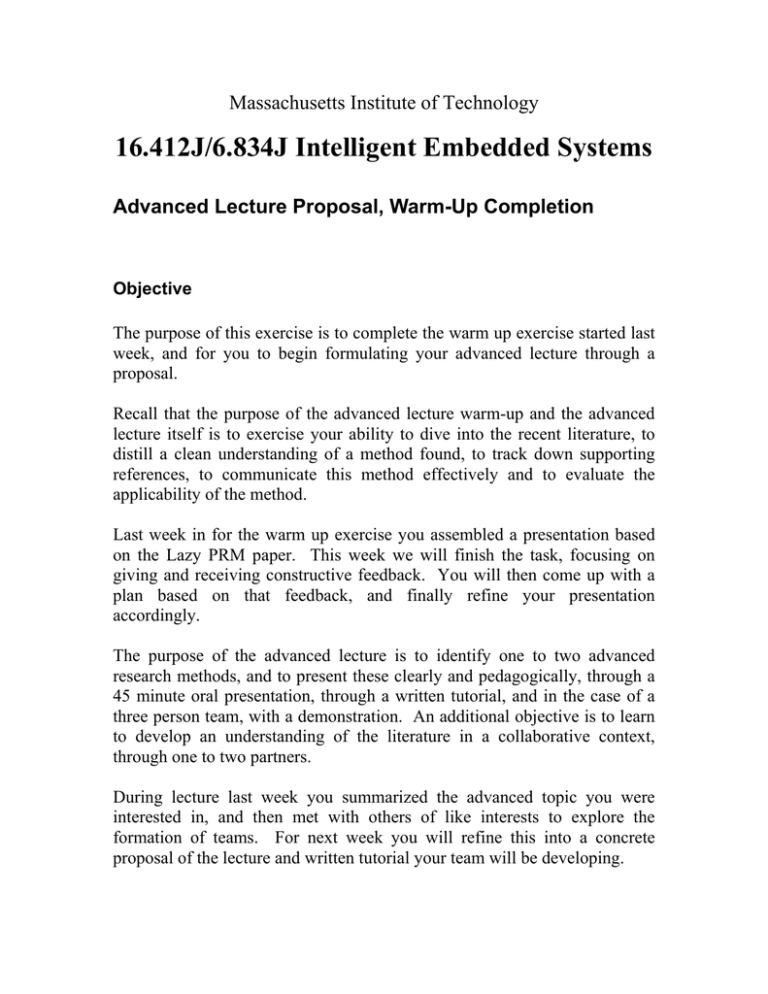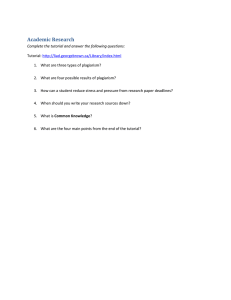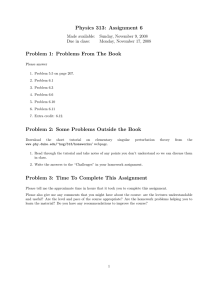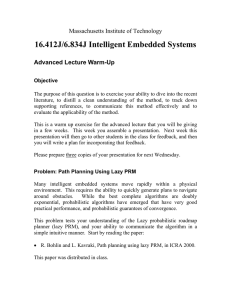Document 13479917
advertisement

Massachusetts Institute of Technology 16.412J/6.834J Intelligent Embedded Systems Advanced Lecture Proposal, Warm-Up Completion Objective The purpose of this exercise is to complete the warm up exercise started last week, and for you to begin formulating your advanced lecture through a proposal. Recall that the purpose of the advanced lecture warm-up and the advanced lecture itself is to exercise your ability to dive into the recent literature, to distill a clean understanding of a method found, to track down supporting references, to communicate this method effectively and to evaluate the applicability of the method. Last week in for the warm up exercise you assembled a presentation based on the Lazy PRM paper. This week we will finish the task, focusing on giving and receiving constructive feedback. You will then come up with a plan based on that feedback, and finally refine your presentation accordingly. The purpose of the advanced lecture is to identify one to two advanced research methods, and to present these clearly and pedagogically, through a 45 minute oral presentation, through a written tutorial, and in the case of a three person team, with a demonstration. An additional objective is to learn to develop an understanding of the literature in a collaborative context, through one to two partners. During lecture last week you summarized the advanced topic you were interested in, and then met with others of like interests to explore the formation of teams. For next week you will refine this into a concrete proposal of the lecture and written tutorial your team will be developing. Problem 1: Feedback on Presentation for Lazy PRM Last week you assembled a slide presentation, with facing pages, on the Lazy probabilistic roadmap planner (lazy PRM), based on the paper: • R. Bohlin and L. Kavraki, Path planning using lazy PRM, in ICRA 2000. For this week you will refine that presentation. Part A Distribute your slides to two other members of the class for feedback, and accept slides from two other members of the class. You should have done this in class on Wednesday. Provide detailed feedback for each set of slides. Send this feedback to the authors on Monday, by class time: • Describe at least three things that you found positive about the presentation. • Describe at least three areas that you feel need to be improved. Please be as specific, detailed and constructive as possible. Turn in a) your original set of slides, and b) the two sets of feedback you received. The authors of the feedback should include their name on the feedback. Part B Between Monday and Wednesday take a second iteration on your presentation. First write a short plan for improving your slides. Restate each area of improvement you received as feedback, and describe concrete modifications you will make to your presentation in order to address that point. Next, generate a second version of your slides that implements your plan. Turn in a) your plan and b) your improved slides. Problem 2: Proposal for your Advanced Lecture Next, assemble a plan for your advanced lecture. It is essential that you do your planning now, so that you will be able to present a high quality lecture, starting in roughly three weeks. For the following, each member of the team should turn in their own proposed plan. This is to ensure that each of you is equally engaged. Form a team of two to three members of the class. Together you will present a 45 minute advanced lecture, and you will write a corresponding tutorial article. If your team has three members, then you will also need to develop a demonstration of one of the methods presented in your lecture. Remember that the objective of the advanced lectures is to clearly and pedagogically present one to two core, advanced methods from the recent literature. Generally these should be methods for developing intelligent embedded systems that perform some form of reasoning or learning within the sense/act loop. The methods should relate generally to material covered within the course. This is NOT a project or application presentation. Application is covered at the end of the semester. Also note that your advanced lecture need not be related to your final project. Part A List the topic of your advanced lecture, the members of your team and the division of labor between team members. Part B List one to two papers that you will cover in your 45 minute lecture. Note that it is very difficult to effectively cover more than one algorithm within a 45 minute lecture. It is generally better to cover less, focusing on both concrete algorithms and examples. Part C Write a brief abstract advertising your lecture. This abstract should be no more than 150 – 200 words. The abstract should highlight the method being presented, the problem it solves, why it is important with respect to creating intelligent embedded systems, what is innovative about the method, and where it has been applied. Part D In addition to your advanced lecture, you will be writing a tutorial article, which you will distribute at the time of your lecture. Please provide an outline of your tutorial article, and your division of labor for writing. The more detailed you are now, the less work to be done later. Part E Provide a list of background references that you will cover in your tutorial. These will form the basis for the bibliography of your tutorial. The list of references is intended to show that you have performed a comprehensive exploration of the relevant literature. Part F (For teams of three) If you’ve formed a three person team, then you have the opportunity to complete this pedagogical process, by assembling a concrete software demonstration of your advanced lecture. Please describe a demonstration that you plan to provide of your selected method, and a plan for developing this demonstration. You may leverage whatever you find over the web.





